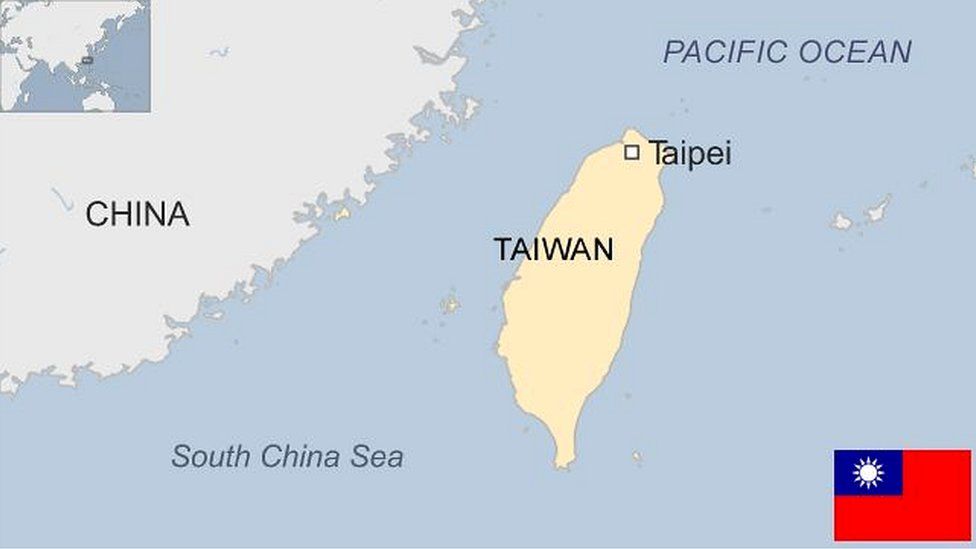Taiwan country profile
- Published

Taiwan is an island that has for all practical purposes been independent since 1950, but which China regards as a rebel region that must be reunited with the mainland - by force if necessary.
China has claimed sovereignty over Taiwan since the end of the civil war in 1949, when the defeated Nationalist government fled to the island as the Communists under Mao Zedong swept to power.
China insists that nations cannot have official relations with both China and Taiwan, with the result that Taiwan has formal diplomatic ties with only a few countries. The US is Taiwan's most important de-facto ally.
Despite its diplomatic isolation, Taiwan - officially the Republic of China - has become one of Asia's major economic players, and one of the world's top producers of computer technology.
- Read more country profiles - Profiles by BBC Monitoring
REPUBLIC OF CHINA: FACTS
- Capital: Taipei
- Area: 36,197 sq km
- Population: 23.8 million
- Languages: Mandarin, Hokkien, Hakka, Formosan, Matsu, Wuqiu
- Life expectancy: 77 years (men) 84 years (women)
LEADER
President-elect: William Lai
Taiwanese voters chose pro-sovereignty candidate William Lai as their president in January 2024, cementing a path that is increasingly divergent from China.
The move angered Beijing, which issued a statement after the results insisting that "Taiwan is part of China". While Beijing has called for "peaceful reunification", it has also not ruled out the use of force.
It was the third presidential election victory for the pro-sovereignty Democratic Progressive Party (DPP). In his first remarks President Lai signalled that this was an irreversible trajectory. "The country will continue to walk on the right path forward. We will not turn around or look backwards," he said.
But Mr Lai also had a message for China and said he favoured more exchanges and dialogue over obstructionism and conflict, and called for peace and stability with Beijing.
At the same time, he added, he would "maintain the cross-strait status quo" - neither seeking independence nor unification with China - and pledged to "safeguard Taiwan from threats from China".
He formally takes office in May 2024.
MEDIA
The media environment in Taiwan is among the freest in Asia, and extremely competitive.
Media freedom organisations say Beijing exerts pressure on Taiwanese media owners.
There are hundreds of newspapers, all privately-owned and reflecting a wide range of views.
TIMELINE
Some key dates in Taiwan's history:
1626 - Spanish establish a trading base.
1642-88 - Dutch expel the Spanish and set up their own settlements. They ally with China's Qing dynasty against Taiwan, but eventually abandon attempts at settlement.
1683-84 - China's Qing dynasty invades the island and formally annexes it, making it part of Fujian province.
1894-95 - First Sino-Japanese war sees Japan defeat China, which cedes Taiwan to Japan under the Treaty of Shimonoseki. Japan's occupation sees the industrialisation of the island, and significant uprisings against Japanese rule.
1945 - Taiwan reverts to Chinese control after Japanese defeat in World War Two.
1946-49 - Chinese Civil War.
1947 - Chinese Nationalist troops crush island-wide rioting by Taiwanese disgruntled with official corruption, killing unknown thousands. The event is now known as the 228 Incident.
1949 - Nationalist leader Chiang Kai-shek loses the civil war to Mao Zedong's Communist forces and flees to Taiwan, along with some two million soldiers, Kuomintang members, and intellectual and business elites. Chiang rules the island until his death.
1949-87 - Martial law era. Martial law is used to suppress political opposition. About 140,000 people are imprisoned or executed for being perceived as anti-Kuomintang or pro-Communist.
1958 - Taiwan Strait Crisis. Communist China shells the Nationalist-controlled islands of Kinmen or Quemoy and the Matsu Islands to probe the extent of the US support for Taiwan. Air and attempted amphibious landings see about 1,000 troops killed.
1950s-1960s - Rapid industrial development.
1971 - UN recognises Communist China as sole government of whole country. People's Republic takes over China's UN Security Council seat.
1975 - Chiang Kai-shek dies.
1979 - Washington switches diplomatic recognition to Beijing from Taipei. US Congress passes the Taiwan Relations Act promising to help the island defend itself.
c. 1978-1980s - Taiwan undergoes reforms and social changes that transform it from an authoritarian state to a democracy.
1987 - Taiwan lifts almost four decades of martial law and eases ban on travel to China.
2000 - Voters put Democratic Progressive Party in power for first time, ending more than five decades of Nationalist rule.
2016 - President Tsai Ing-wen calls on the international community to defend democracy in the face of renewed threats from China and calls on the latter to democratize and renounce the use of military force against Taiwan.
2021 - China sends military aircraft into Taiwan's air defence zone, a self-declared area where foreign aircraft are identified, monitored, and controlled in the interests of national security.
2022 - Relations between Taiwan and China deteriorate sharply following a visit to the island by US House Speaker, Nancy Pelosi. China carried out military exercises, including the firing of ballistic missiles, focussing on six zones around Taiwan, three of which overlap the island's territorial waters.
2024 - Taiwanese voters choose pro-sovereignty candidate William Lai as president. The move angers Beijing, which issues a statement after the results insisting that "Taiwan is part of China".
Related Topics
- Published25 August 2023
- Published19 July 2023
- Published26 July 2023
- Published5 July 2023
- Published5 April 2023